Armored cars Lancia 1Z (Italy)
In 1912, Lancia began supplying the army with a new two-axle truck 1Z or 1-Zeta. This machine was a further development of the previous truck brand "Lancia" with enhanced performance. Probably, the relatively high characteristics of this car attracted the attention of Ansaldo specialists, who at the end of 1914 of the year began developing a promising armored car. It was proposed to use the existing chassis with a new original armored body. Similar equipment could be offered to the army and, possibly, to receive an order for its mass production.
It is noteworthy that the design of the new armored car inherited the name of the base truck Lancia 1Z, but was not named after the developer company. As a result, the combat vehicle remained in stories just like “Lancia”, and not like “Ansaldo”.
The Lancia 1Z armored car was, by its architecture, a typical representative of its class, created during the First World War. It was proposed to install a special armored case on the base chassis of a serial truck. Used chassis also did not differ originality of design. It had a frame on which bridges with leaf springs were installed. The transmission design provided the transmission of torque to the rear axle, because of which the car had the wheel formula 4х2. The front axle was connected to the steering gear.
The base chassis of the new armored vehicle was equipped with a four-cylinder petrol engine of the company "Lancia" 60 hp power. The main element of the transmission was a four-speed gearbox, also developed by the manufacturer of the truck. The wheel chassis was initially equipped with four single-wheel wheels, but over time, production cars began to receive dual rear wheels, ensuring the correct distribution of the weight of the load. As a basis for the armored car used a later modification of the chassis with twin wheels.
The armored body of the car was proposed to be assembled from several metal sheets of various shapes and sizes. Sheets were used with thickness from 2,5 mm (bottom) to 6 mm (all other parts). All sheets of armor were mounted on a metal frame with rivets. Welded joints were not used due to the lack of necessary technologies. The armor case of the Lancia 1Z machine had a standard construction for such equipment and was divided into two parts: the engine compartment and the crew compartment. However, some new original ideas were used in the hull design.
The front of the case was an armored engine cover. It consisted of two front sheets with cut-out blinds, vertical sides with similar cut-out and curved parts, as well as two inclined upper covers. The latter were hinged to the center beam of the bonnet, which made it possible to lift them for servicing engines. The bonnet design used provided acceptable engine protection and did not interfere with ventilation and air access to the radiator. On the front wall of the hood there was a headlight.
The front part of the housing volume was a control compartment with a driver’s workplace located on the machine’s longitudinal axis. To ensure acceptable hull volumes, the front part of the sides was located at an angle to the machine axis. This part of the sides was connected with a sloping frontal sheet with a viewing hatch and an armored lid with a slot for observing the road in a combat situation. Behind the beveled sheets there were two straight vertical side sheets. The driver's door was located on the left; there was a spare wheel mount on the right. In the door and starboard there were small inspection hatches with lids.
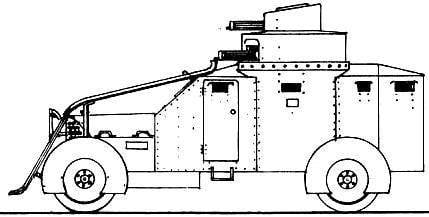
Scheme armored Lancia 1Z Serie I
If necessary, aft post control should be used. In the stern overhang of the hull a simplified set of instruments and controls of the machine was envisaged. Thus, the second driver could take the car out of the battlefield in reverse. In addition, at that time, the concept of “supplying” an armored car on the battlefield astern to the enemy was formed. In this case, the second driver was responsible for the nomination to the specified position.
Behind the department of management there was a fighting department with shooters' workplaces. Any partitions between these parts of the body were not provided. Ansaldo engineers proposed an original and unusual armament complex, which affected the design of the armored vehicle hull. In the front of the fighting compartment, the hull sides had a curved outward shape and were parts of a cylinder, at the top of which there was a tower shoulder strap. In the rear part of the conditional cylinder was mated with aft box-shaped hull. The roof of the command and aft section of the fighting compartment had a curved shape and rose next to the shoulder strap of the tower.
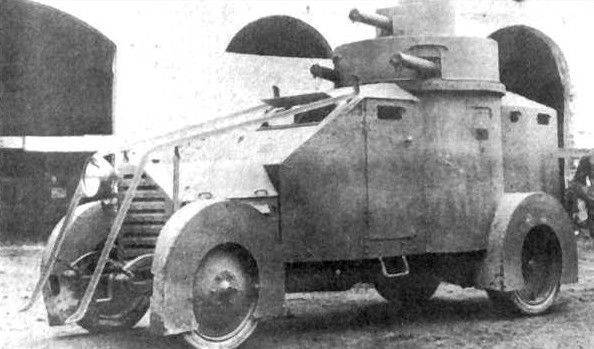
Armored Car Lancia 1Z Serie I
In the curved right side of the hull, a door was provided for access to the fighting compartment. Several inspection hatches were provided on both sides of the fighting compartment: one each in the curved sides and the rear. There was also a flap in the stern sheet. For additional protection of the crew, all hatches were equipped with lids to be closed from the inside.
Provided wheel protection. For this machine received a set of semi-circular wings, covers, covering the wheels on top. Initially, a complete set of similar protection was offered, but later on the machines began to receive only wings for the rear wheels. The chassis frame was closed with the lower part of the hull sides.
Of great interest is the original set of weapons. At the suggestion of the designers, the armored car Lancia 1Z had to carry three machine guns at once. On the roof of the hull, directly above its curved part, there was a round shoulder strap tower. It was proposed to mount a large main turret with two machine guns. Fastening systems allowed to direct weapon within a small horizontal sector and fire with an elevation from -15 ° to + 35 °. Two machine guns were controlled by two different arrows, which were located at the sides of the tower. They were responsible for the coordinated rotation of the main tower in the right direction.
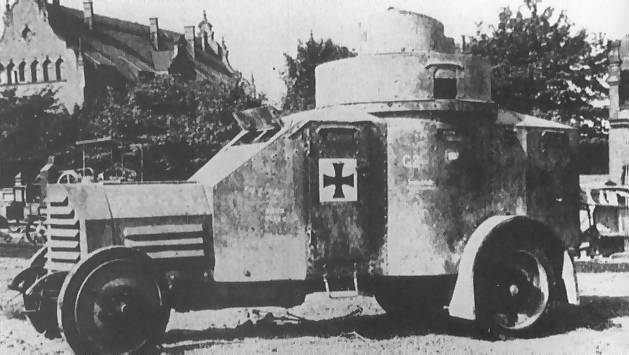
Trophy armored car Lancia 1Z Serie I with Austrian insignia
To increase firepower, the first version of the armored car 1Z received an additional small-sized turret with one machine gun. It was placed on the roof of the main tower. The small tower had its own guidance mechanisms and was controlled by a third shooter. It was assumed that the use of two towers with three towers would simultaneously attack several targets in a relatively wide sector.
As a weapon, the Lancia 1Z armored car carried three Maxim machine guns with a total ammunition in 15 thousand cartridges. In addition, the crew could have their own weapons in the form of rifles in the army. The crew could also be armed with hand grenades and other weapons for self-defense.
The crew of the new armored vehicle consisted of 5 or 6 people. It included a driver, a commander and three machine-gunners. If necessary, a second driver could be involved in driving a car, after which the crew increased to 6 people. It should be noted that half of the crew (three arrows) was located in the central part of the habitable volume, under two towers. Already during the tests it was established that only the commander and drivers have acceptable working conditions. The shooters, in turn, had to work in cramped quarters.
Italian designers had the necessary information on the course of the battles on the fronts of the First World War, thanks to which the new armored car received a system for overcoming wire obstacles. Two curved rails were fastened on the bonnet and frontal section of the control compartment. In their lower part, they had to hook up the wire and tear it. Part of the barriers could slide onto the upper rear part of the rail, at the end of which a protruding hook was provided that could break the wire.
The combat weight of the Lancia 1Z armored car was 4,2 t. The car was quite compact. Its length did not exceed 5,4 m, and the width - 1,8 m. The height of the roof of the small tower was 2,4 m. The power density at the level of 14-15 hp per ton of weight allowed the armored car to reach speeds up to 50 km / h on the highway. Fuel tanks allowed to get to 200 km without refueling. There was the possibility of climbing a small slope, overcoming shallow water obstacles ford, etc.
In May 1915, Italy became a member of the First World War. Shortly thereafter, construction began on the first prototype of an armored car based on the Lancia 1Z truck. In August, the prototype machines showed the military. The potential customer praised the solid armament and good protection of the armored car. In addition, sufficiently high driving performance was provided. It did not go without a claim. The fighting compartment was considered close, the control from the aft post was too difficult, and the high load on the surface had a negative effect on maneuverability. It was also found that the crew has insufficient visibility from their workplaces and from the hull.
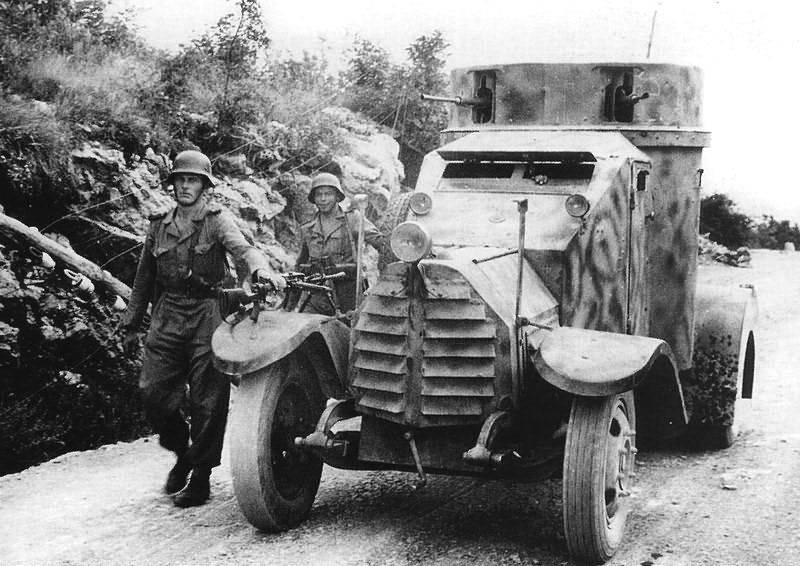
Armored Car Lancia 1Z Serie III / 1ZM
Soon, Ansaldo experts prepared an updated project that completely satisfied the military. Such cars soon went into the series. The Lancia 1Z Serie I armored vehicles received an updated armored engine hood. A set of new inspection hatches appeared in the hull: their total number was brought to 14. In addition, it was decided to abandon the installation of protection of the front wheels.
For certain reasons, Ansaldo could not quickly carry out all the necessary improvements and deploy a full-fledged production of updated machines. The first armored vehicles of the 1 Series were transferred to the army only in the middle of the 1916 year. Within a few months, no more than 20 of such vehicles were manufactured and handed over to the troops.
In the summer of 1916, the design of a new version of the armored vehicle was completed. This time, it was decided to remove some inspection hatches of the hull, change the design of the rails to break through the barriers, and modify some other elements of the machine. In addition, the machine has received new attachments for machine guns. Now it was possible to use not only the existing Maxim, but also St. Etienne M1907 French production. Updated armored cars were produced in the framework of the so-called. “Series II” (Lancia 1Z Serie II).
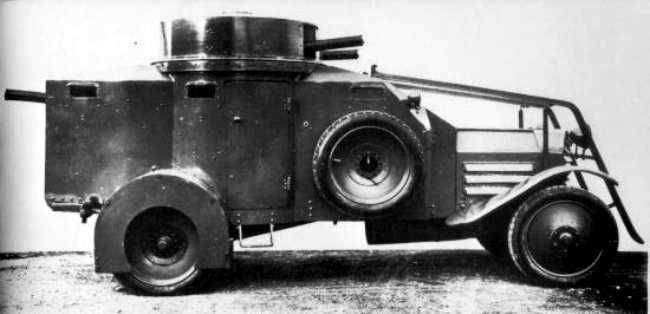
Armored car Lancia 1ZM
After the start of production of the second serial modification, the development of the next modernization project started. This time it was supposed to take into account all the features of the operation of equipment and further improve its characteristics. Modification Lancia 1Z Serie III, also known under the designation 1ZM, differed from the basic number of features.
Due to the narrowness of the fighting compartment and the lack of serious advantages in the double-tower scheme, it was decided to abandon the small tower. The released machine gun was transferred to the embrasure of the hull's stern sheet. In place of a small tower in the main roof, a hatch appeared. Some modifications underwent housing. Over time, FIAT-Revelli M1914 machine guns were to become the main weapon of the new armored vehicles. However, for a long time, the serial "Lancia" 1ZM armored cars were equipped with existing Maxim machine guns, because the gunsmiths did not have time to produce the required number of new machine guns.
Production of armored vehicles of the third series began in November 1917 of the year. In accordance with the signed contract, the army should have received 35 of such vehicles. The operation of the first serial Lancia 1ZM showed the advantages of the updated design and led to an increase in order. In January, 1918 was decided to purchase 100 machines, including those already delivered.
Until the end of World War I, Ansaldo, with the direct support of Lancia, produced at least 100-105 1Z armored cars in three versions. Some sources mention numbers from 85-90 to 113-115 machines, including the first prototype. All serial equipment was actively used in battles.
The first armored cars "Lancia" 1Z got into the army in the middle of the year 1916. Due to certain reasons, during the first months this vehicle almost did not participate in the battles. It was used several times to support infantry, but the mass exploitation of new armored vehicles began only next year. It should be noted that during the First World War, armored cars were used not only in battles with the enemy, but also during the suppression of insurrections that occurred several times in Northern Italy.
At the end of October 1917, the Italian squadrons, armed with armored vehicles of the new model, suffered serious losses. At the beginning of the Battle of Kaporetto, the enemy carried out successful artillery preparation and seriously disrupted the control of the Italian troops. Due to the lack of normal control, the crews of the armored cars were forced to act according to the situation, because of which about a dozen vehicles were abandoned or destroyed by artillery.
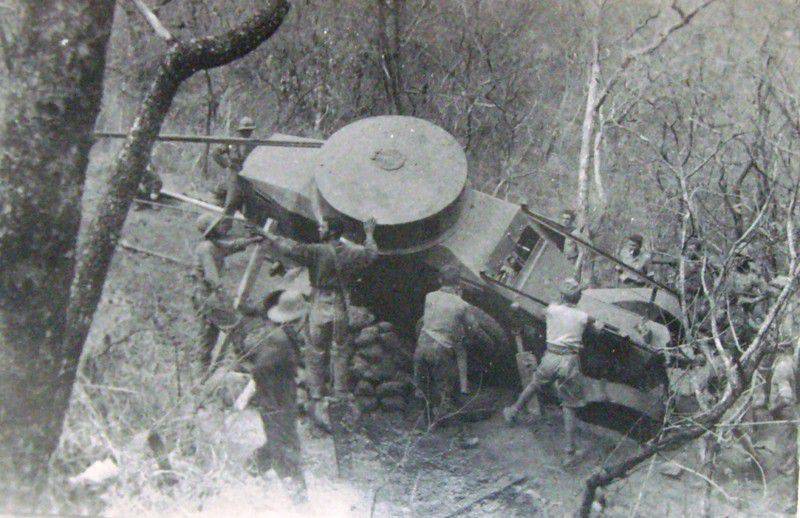
"Passed". Armored car Lancia 1ZM
In the future, the command carried out an analysis of past battles and made conclusions. By the fall of 1918, a special guide was issued on the use of armored vehicles in combat. Literally a few days after that, at the end of October, the 15 squadrons that were in the ranks successfully took part in several battles without suffering any serious losses.
After the end of the First World War, several new squadrons were formed as part of the armed forces of Italy, and no more than four dozen armored vehicles of the Lancia 1Z were transferred to several modifications. In the interwar period, all this technique was used for police purposes, and was also used to quell uprisings in the colonies. Such equipment participated in battles in Ethiopia, Libya, etc.
In 1936, several armored cars of the “Lancia” 1Z, together with volunteer soldiers, went to Spain. Of the eight cars until the end of the civil war, only three survived. Already during the first battles, it was found that such equipment could not be effectively used in combat operations in urban environments. In addition, the armor of the machines could not withstand hitting from rifles at relatively short distances. The three surviving armored vehicles in February 1939 participated in the parade in Barcelona.
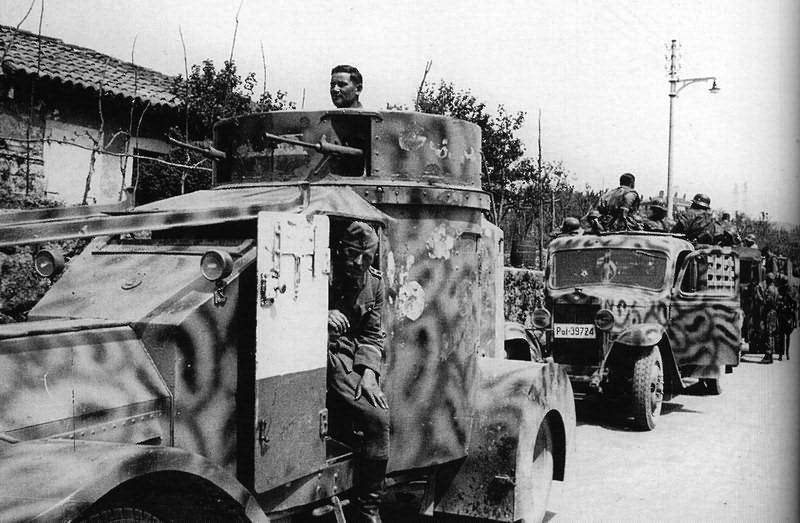
Lancia 1ZM and German soldiers
Part of several types of armored vehicles Lancia 1Z was transferred to foreign countries. In 1919, two cars went to Czechoslovakia, where they were first used by the Italian military, and then transferred to the local army. Both armored cars were operated until the end of the twenties.
After World War I, one armored car of the 1ZM type was sold to Afghanistan. There, the car was used for some time, after which it was sent to the eternal parking lot, where it was plundered. According to some reports, at the end of 2000, the remains of the only Afghan Lancia 1ZM were discovered by ISAF soldiers.
Several armored cars during the fighting became trophies of Austria-Hungary. Machines that had no serious damage were actively used in battles against former owners. Damaged equipment remained in the Austro-Hungarian rears. At least one armored car has undergone a major modernization. His body was installed on the chassis of a truck owned by the new owners, and Italian machine guns were replaced by German-made weapons.
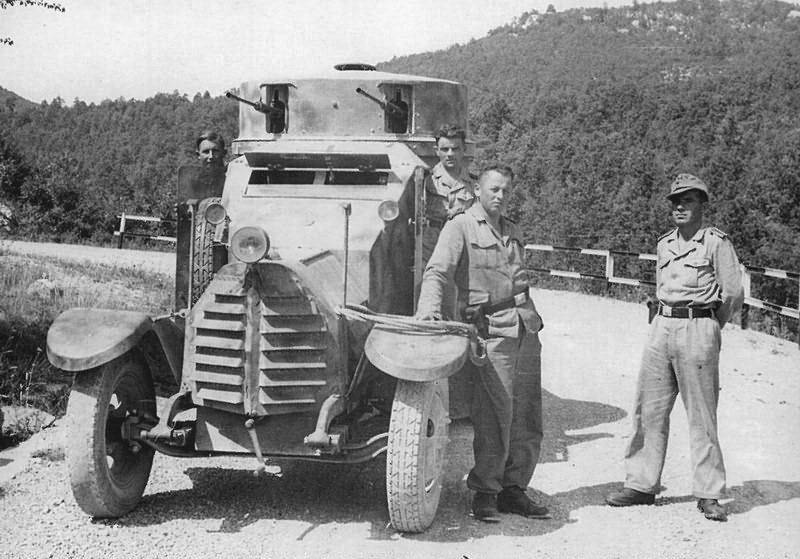
Lancia 1ZM and its crew
By the beginning of World War II, the Italian army had no more than 40-45 armored vehicles of all types of Lancia 1Z. Part of this technology was involved in the fight against partisans in the Balkans, but the majority of the armored cars stood idle or were training machines. After the capitulation of Italy in September 1943, the Germans managed to recapture several surviving armored vehicles, which were restored and returned to service. However, these machines were not actively used.
Of the more than a hundred built Lancia 1Z armored cars of three modifications, only a few have survived to date. All of them are exhibits of museums and private collections. The specimen discovered in Afghanistan was taken abroad for restoration. In addition, there are several replicas that, like the originals, are in museums in Italy and other countries.
On the materials of the sites:
http://aviarmor.net/
http://regioesercito.it/
http://alternathistory.org.ua/
http://italie1935-45.com/
http://autonet.ru/
- Ryabov Kirill
- The-blueprints.com, Aviarmor.net
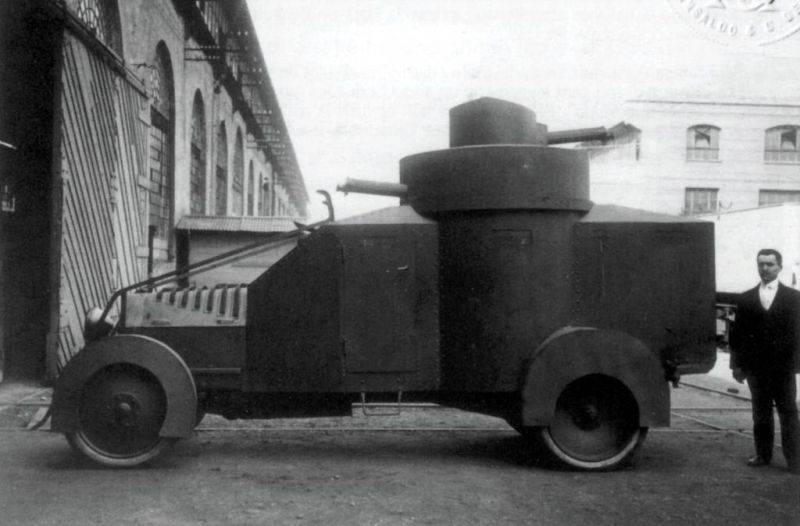
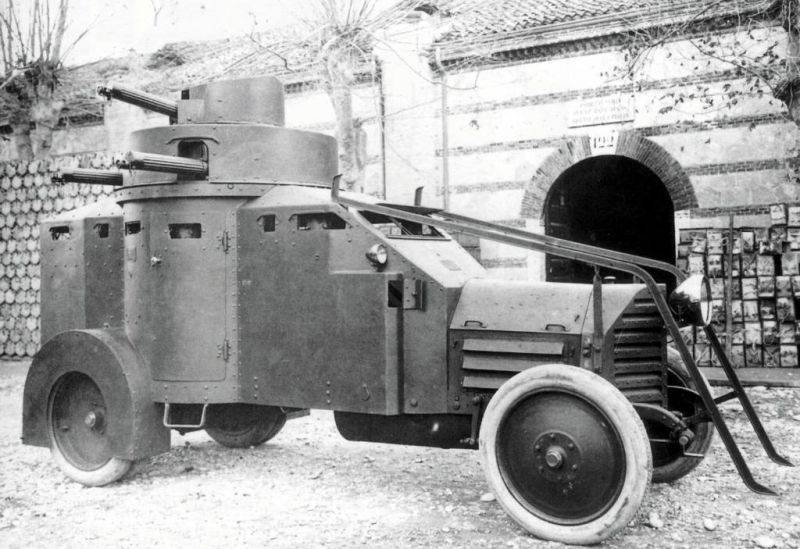
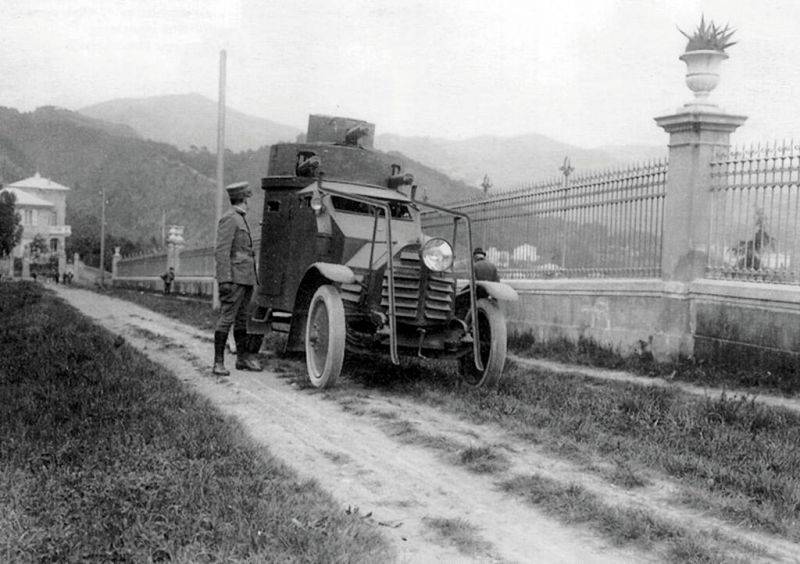
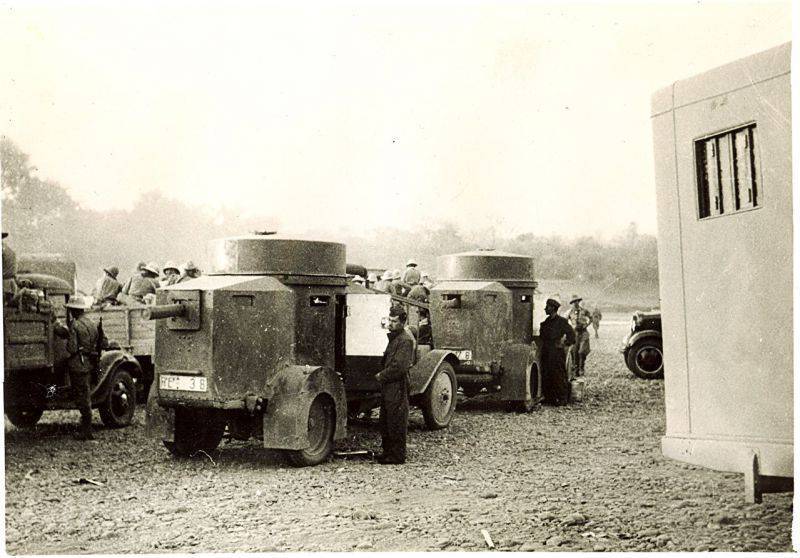
Information